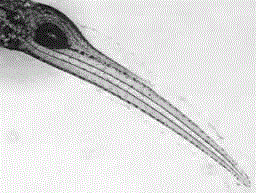Rosa davurica pall extract and applications thereof
A kind of extract, the technology of thorn rose, applied in the thorn rose extract and its application field
- Summary
- Abstract
- Description
- Claims
- Application Information
AI Technical Summary
Problems solved by technology
Method used
Image
Examples
Embodiment 1
[0037] The preparation of embodiment 1 Rosa japonica extract
[0038] (1), preparation of Rosa japonica flower extract: add 70% ethanol 1000mL after pulverizing 100g of Rosa japonica flower, ultrasonically extract 2 times at room temperature, each 1 hour (also can adopt stirring extraction, reflux extraction etc. commonly used Extraction method, preferably ultrasonic extraction), then filter, the solvent of the filtrate is concentrated to 50ml under reduced pressure, adsorbed with AB-8 resin column, and eluted with deionized water, 30% ethanol, 70% ethanol and 95% ethanol successively, respectively After the collection, the solvent was distilled off under reduced pressure to obtain a dry solid, which was weighed to obtain 2.95 g of the 30% ethanol part, 9.89 g of the 70% ethanol part, and 2.45 g of the 95% ethanol part of the rose flower.
[0039] (2), preparation of Rosa japonica fruit extract: add 70% ethanol 1000mL after pulverizing 100g of Rosa japonica fruit, ultrasonical...
Embodiment 2
[0043] Example 2 Research on Antioxidant Activity of Rosa japonica Extract
[0044] With the extract of Rosa japonica prepared in Example 1, its free radical scavenging activity was measured by the DPPH method, with VC as a reference. The determination procedure is: the extract of Rosa japonica is prepared into an aqueous solution with deionized water respectively, pipette 2 mL into a 10 mL stoppered test tube, add 2 mL of DPPH ethanol solution (2×10 -4 mol / L), fully mix, stand at room temperature, measure the absorbance A of 517nm wavelength with a spectrophotometer after 30min 517 (with ethanol as a reference); simultaneously measure the absorbance A after mixing 2mLDPPH solution with 2mL ethanol c , and the absorbance A after mixing 2mL extract with 2mL ethanol solution 0 , measured in parallel three times, averaged, and calculated the free radical scavenging rate according to the following formula.
[0045] Free radical scavenging rate = (1-(A 517 -A 0 ) / A c )×100%. ...
Embodiment 3
[0051] Example 3 Research on the Inhibition of Elastase by the Extract of Rosa japonica
[0052] The extracts of Rosa japonica prepared in Example 1 were respectively dissolved in deionized water to prepare an aqueous solution for measuring elastase inhibitory activity. The assay method was carried out according to the literature (Am.J.Pharmacol.Toxicol., 2009, 4, 127-129), and the assay steps were: add 10 μL sample solution and 130 μL containing 1.015 mM reaction substrate Succ-Ala-Ala- Ala-p-nitroanilide 0.1M Tris-HCl buffer solution (pH8.0), incubate at 25°C for 5 minutes, add 15μL elastase solution (0.5U / ml), continue to incubate at 25°C 30min, then measure the absorbance A at 410nm wavelength with a microplate reader 410 . The sample aqueous solution was replaced with deionized water, and the absorbance was also measured as a reference solution. The test results are shown in Table 2.
[0053] The formula for calculating the inhibition rate of elastase activity is: inhi...
PUM
 Login to View More
Login to View More Abstract
Description
Claims
Application Information
 Login to View More
Login to View More - R&D Engineer
- R&D Manager
- IP Professional
- Industry Leading Data Capabilities
- Powerful AI technology
- Patent DNA Extraction
Browse by: Latest US Patents, China's latest patents, Technical Efficacy Thesaurus, Application Domain, Technology Topic, Popular Technical Reports.
© 2024 PatSnap. All rights reserved.Legal|Privacy policy|Modern Slavery Act Transparency Statement|Sitemap|About US| Contact US: help@patsnap.com










